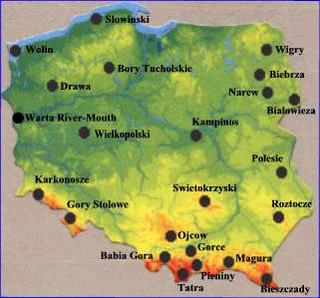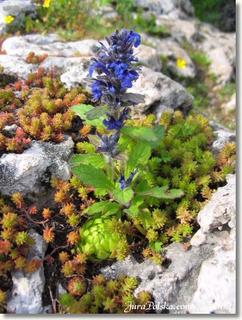Hello:)
Well... I am comming back to continue my English language blog after a couple of days of break. I didn’t plan this break at all like I didn’t plan many other things in my life. It just happened against my will but now the highest time to go on.
In all my entries till today I tried to be focused rather on achievemnets and merits of local nature protection, specially within the area of my familiar Silesian Voivodeship.
This region is mostly known for its industrial past and it used to be a centre of coal-mining, steel-mining, Polish chemistry and similar industries till 1990 when Polish government recognized this all Silesian industry as having no perspective because of its little profit and decided both to privatize the best factories and close down the rest with no other option for unemployed people unlike encouraging them to leave faster and faster via giving big so-called dismiss money and some profits/low-rated loans for those brave who would decide to set up their own businesses instead of working in state ones.
This way Warsaw government made up another crazy and unrealistic idea of how to change a hard working Silesian miner into capitalistic manager of his own firm.
As wise people who read this message can suspect miners took their dismiss money, bought a car and some furniture and started to overuse alcohol the more after having no money and job soon.
Well but you can ask me rightly at this moment what these economical problems I have described above have to do with environmental protection? Oh – a lot of – I would answer.
Silesia isn’t any mining centre today, any steel basin anymore, no smoking chimneys, no noise, no dirt in the air. We still have 8 Nature Parks and the air here is now totally clear. I mean you can breathe it in without any fear of causing a cancer of your lungs in the future cause no fumes anymore now! This way - you can see –evidently something must be lost to have a gain somewhere else .
This Nature Park I do my research in was established in 1998. So it is rather a young Nature Park. Alltogether the idea of Nature Parks system in Poland is rather new because its has been started in 70ties of last century but this is a good subject for another entry of mine.
But comming back into reasons of setting up this particular Nature Park – the origins of its beginning are very complicated but still totally simple as I will tell to you another day. Truly speaking I think it has very few botanical values and (in my opinion) it would be totally enough to establish within its area 3-4 natural reserves to be sure we did for nature everything we were able to do and everything we should have done. But of course (like in case of my unplanned break in writing this blog) very few things in life go the way they should go (at least this is my life-experience).
So instead of writing about plant cover of peatbogs I would like to present you today a pla
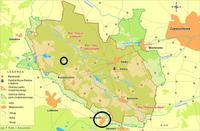
ce that was supposed to be recognized the biggest watery reserve in official plans/documents of this Nature Park in year 2000 (so called "The Old Birch" area) but which place has been totally totally devastated since that time and I still wonder how could it happen, who agreed to bring any excavators there and what for some people simply totally destroyed this really immpressive watery ecosystem of "The Old Birch" area cause that is local name for this place. Now look at the map on your right above to see on the map of the Park where is this place.
When I saw this place in 2001 I was really enchanted and it looked like on the picture b
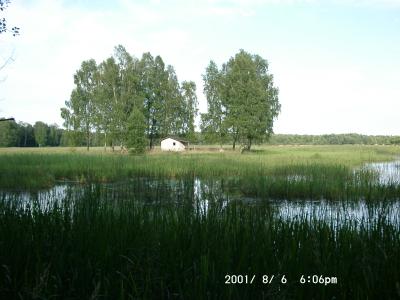
eneath:
I even tried to call some people to get some informations who and what for destroyed it but one of them who seemed to me he should have been really against this common thoughtless devastation (I still cannot see any reason in this all digging and drainage there) started to shout at me that he used to be a director in Poland for about 15 years and I would not be telling him what he should or shouldnot do. His telephone (he called me back to shout at me these things) seemed to me to be really insane – I was just looking for him simply to find out something more what he was thinking about this whole mess there – thus I gave up my further investigation because I really didn’t want to have any problems because of it:(
As deals landscape of this place in 2002 it changed and looked like beneath:
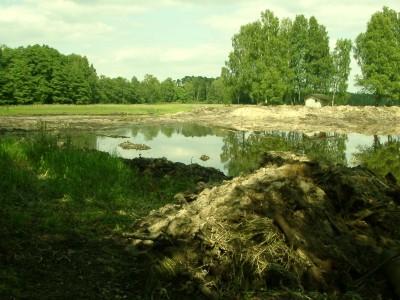
Well, however, I have to admit, till today everyone lies that everything is OK, still any fish in this large pond you can find so I really still don’t understand why 3 years ago someone let out whole water there and digged out tonnes of earth (probably to make it deeper but think what a cost for whole ecosystem there and all in all present level of water is merely half of it used to be in year 2000).
Well… nasty thing you have to admit. But ecologists never waste their time so in the meantime I found there many so called muddy plant assosiations and did my next research as deals new ecological processes that are started in this place – like partial regeneration of these few flora elements that still could find appropriate living conditions there and appearing of new components with a course of succession (like the mentioned above and rarely met in Poland muddy plant asscociations that certify that water in this particular pond used to be really of a highest quality). Look at the next picture below :
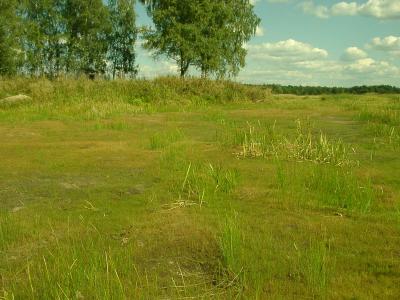
The most ironical message is for last. Till today noone wants to answer me what intentions were behind these illegal actions within the area of the pond and water flows of “The Old Birch” –the area of planned watery nature reserve within borders of Nature Park “Forrests upon Upper Liswarta River” and why so many rare watery and moisture-liking plants lost once and forever their seats cause present level of water in this tank is much lower than it used to be and half of the flood waters has still been drying on purpose.
I mean I think I do know who and why decided to dry out this beautiful place but I would have to go to court again and normally sue this man. Hmmm… I am not a worker of Nature Parks adminstration to do such things. And what do the last do? –someone can ask me. Well…in the meantime they built a wooden observatory platform for visitors there to make them possible to admire a puddle that is left after what used to be the amazing flood waters and published next publications about values of watery ecosystems within area of Nature Park “Forrests upon upper Liswarta River”. And here is the mentioned above observatory platform:
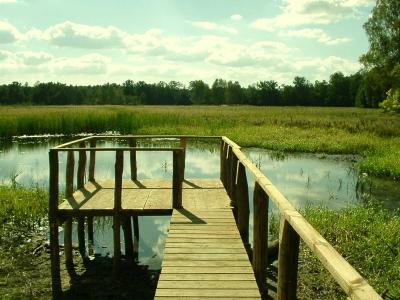
AMEN for today. Better news in next entry. I do hope that after some effort is possible to understand my English.
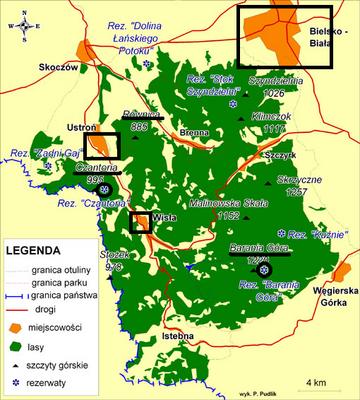
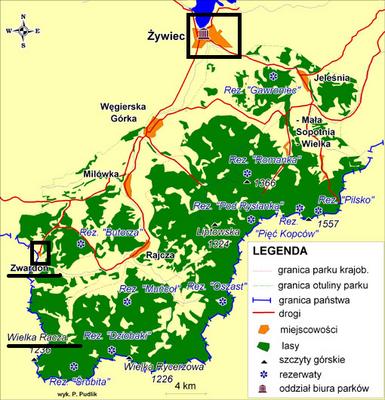 This time only two rectengulars and two underlined things. First marked rectengular is at the top of the screen and marks Zywiec town - everyone who once visited Poland should know what kind of beverage is produced in Zywiec. If you don't know I can help you - the most popular (probably) Polish beer. Though I am not sure if this beer is the most popular cause I simply don't drink any beer at all:( Second rectengular on the map above marks Zwardon town - the town you have to reach (for example by train) when you want to climb WIELKA RACZA mountain (1236 m) - that is about 4 hours on foot from Zwardon. There is a hotel on Wielka Racza and you can eat something and sleep there to start new trail the next day. Of course there are many other interesting peaks and places both in Beskid Sląski and Zywiecki but I am not able to write about everything in one entry. I like Wielka Racza very much cause when you are lucky from observatory platform on its peak you can see some views of mountains that you can never forget:)
This time only two rectengulars and two underlined things. First marked rectengular is at the top of the screen and marks Zywiec town - everyone who once visited Poland should know what kind of beverage is produced in Zywiec. If you don't know I can help you - the most popular (probably) Polish beer. Though I am not sure if this beer is the most popular cause I simply don't drink any beer at all:( Second rectengular on the map above marks Zwardon town - the town you have to reach (for example by train) when you want to climb WIELKA RACZA mountain (1236 m) - that is about 4 hours on foot from Zwardon. There is a hotel on Wielka Racza and you can eat something and sleep there to start new trail the next day. Of course there are many other interesting peaks and places both in Beskid Sląski and Zywiecki but I am not able to write about everything in one entry. I like Wielka Racza very much cause when you are lucky from observatory platform on its peak you can see some views of mountains that you can never forget:)






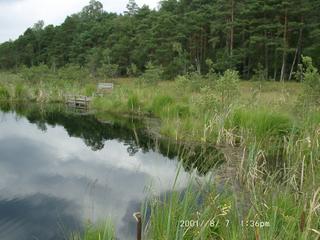

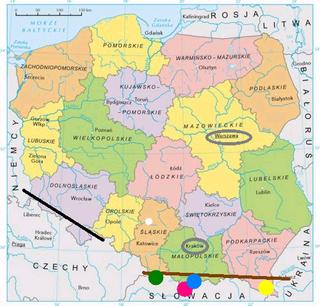 Hello:)
Hello:) 